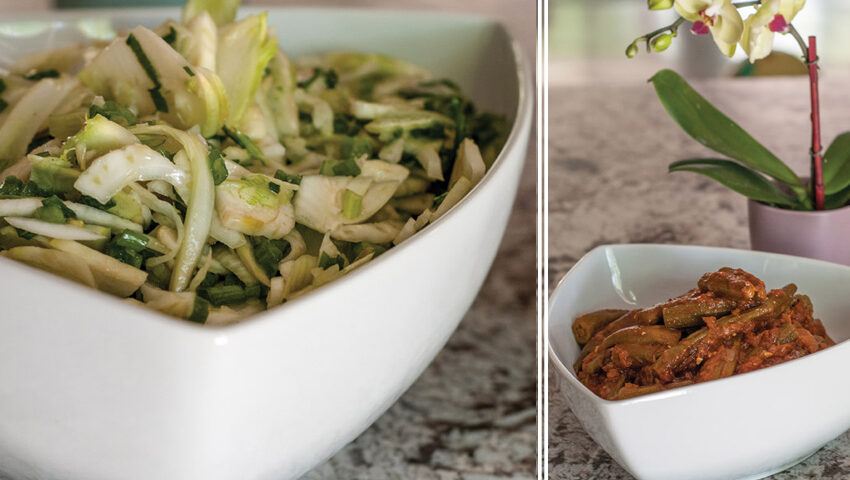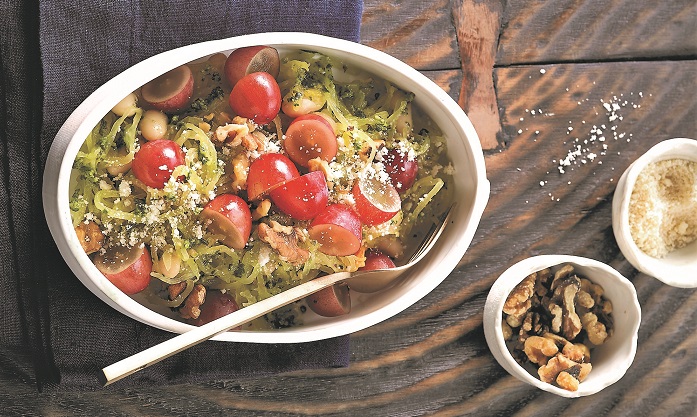Photos by Matthew Strauss
The joy of discovering a new delicious vegetable may inspire you to broaden your culinary journey. We get so used to the familiar and “safe” staple vegetables day in and day out that we forget the colorful and tasty bouquet of other fruits and vegetables that await us.
Kale is an example of veggies waiting to be discovered. No one knew about it or even knew what to do with it until we became courageous and dared ourselves to explore something new.
The change of seasons has always motivated me to try new recipes or add a new food or spice. This spring I was introduced to kohlrabi, which resembles a cross between a radish, cabbage and artichoke, and is shaped like a beet. I just had to know what the heck this strange looking vegetable was, and what to do with it. Eaten raw, kohlrabi has a faint bite like a sweet radish and tastes like the happy marriage of a turnip and cabbage. You can roast kohlrabi or saute its leaves like you would Swiss chard or kale.
My other curious foe was okra. This one is a hard sell, because either you’re going to love it or hate it for its unique mucilaginous (think sticky or slimy) texture. It’s important to cook or dehydrate it for a perfect introduction to this very tasty vegetable. Chopped or sliced, okra can be stewed or fried (fritters) under low-heat oil in order to soften its texture. It then can be mixed with other vegetables, rice or meat.
Aside from the flavor, some of the best reasons for eating kohlrabi and okra are the nutritional benefits. Low in carbs and calories but high in dietary fiber and antioxidants, these vegetables are a dieter’s dream. So the next time you are at a farmers market, look for those unfamiliar veggies and dare yourself to explore.
Fennel and Kohlrabi Salad
3 medium kohlrabi, peeled thinly
3 large bulbs fennel
1 bunch scallions, white and light-green parts, cut on the diagonal into ½-inch slices
Juice from 3 large lemons
¼ cup extra virgin olive oil
Kosher salt
Cut the kohlrabi and fennel in half; discard the cores. Cut the halves into very thin slices and place in a large mixing bowl. Add the scallions, lemon juice and oil, mixing well to combine. Add the salt and taste; adjust accordingly. Serve chilled or at room temperature.
Middle Eastern Okra
2 pounds okra
2 tablespoon olive oil
1 onion, minced
1 teaspoon minced garlic
1½ cups hot water
¼ cup tomato paste
1 teaspoon salt, or more to taste
1 teaspoon smoked paprika (or substitute regular paprika)
½ teaspoon red pepper flakes (optional)
¼ teaspoon cayenne, or to taste
Prepare the okra by rinsing it clean, then slicing off the top and bottom tips of each piece. At this point the okra will feel slimy. Don’t worry, it will lose that texture as it cooks.
Heat 2 tablespoons olive oil in a saute pan over medium heat. Add the minced onion and saute, stirring frequently, for about 10 minutes until softened and starting to caramelize.
When the onions are cooked, add the minced garlic to the pan and saute for another minute till fragrant. Add the okra to the pan and stir. It will feel like a lot of okra at first and the pan will be crowded, but it will quickly shrink up and soften as it cooks.
Whisk together hot water, tomato paste, salt, paprika, red pepper flakes and cayenne. Both the red pepper flakes and cayenne add heat.
Pour the tomato liquid evenly over the top of the okra. Bring to a boil.
Cover the saute pan with a lid, vented at the edge. Reduce heat to a simmer. Let the okra cook for about 20-30 minutes, stirring every 5 minutes or so until the largest pieces of okra have softened to your liking. Add more salt or spice to taste, if desired.
Serve okra hot. It may be served alone, but if a more substantial meal is desired, serve over rice, quinoa or couscous.






